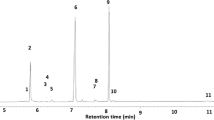Abstract
Field tests with live, caged females and whole-body extracts of females of the caddisflyGumaga griseola (McLachlan) (Trichoptera: Sericostomatidae) demonstrate, for the first time, the existence of a chemically mediated sexual communication system in this insect order. Both live females and extracts are significantly more attractive to conspecific males than either empty control traps or traps baited withGumaga nigricula (McLachlan) females. Anatomical structures suggest that semiochemicals are widespread in Trichoptera.
Similar content being viewed by others
References
Benz, G. 1975. Über die Tanzschwärme der KöcherfliegeHydropsyche pellucidula Curtis (Trichoptera: Hydropsychidae).Mitt. Schweiz. Entomol. Ges. 48:147–157.
Betten, C. 1934. The caddis flies or Trichoptera of New York State.N. Y. State Mus. Bull. No.292. 576 pp.
Birch, M.C. 1974. Pheromones. North Holland, Amsterdam. 495 pp.
Cummings, B.F. 1914. Scent organs in Trichoptera.Proc. Zool Soc. London 1914(2):459–474.
Duffield, R.M. 1981. 2-Nonanol in the exocrine secretion of the nearcticcaddisfly,Rhyacophila fuscula (Walker) (Rhyacophilidae: Trichoptera).Proc. Entomol. Soc. Wash. 83:60–63.
Duffield, R.M., Blum, M.S., Wallace, J.B., Lloyd, H.A., andRegnier, F.E. 1977. Chemistry of the defensive secretion of the caddisflyPycnopsyche scabripennis (Trichoptera: Limne-philidae).J. Chem. Ecol. 3:649–656.
Dunnett, C.W. 1955. A multiple comparison procedure for comparing several treatments with a control.J. Am. Stat. Assoc. 50:1096–1121.
Eltringham, H. 1919. On the histology of the scent-organs in the genusHydroptila, Dal.Trans. R. Entomol Soc. London 1919:420–430.
Esch, G.W., andCoggins, J.R. 1974. Studies on the population biology ofCrepidostomum cooperi metacercaria in the burrowing mayflyHexagenia limbata.Trans. Am. Microsc. Soc. 93:430 (abstract only).
Kelner-Pillault, S. 1975. Attirance sexuelle chez un Trichoptère:Enoicyla pusilla Burmeister.Bull. Soc. Entomol. Fr. 80:252–257.
Kimmins, D.E. 1956. Scent production by caddisflies.Country Side, London. 17:368–369.
Mosely, M.E. 1919. Scent-organs in the genusHydroptila (Trichoptera).Trans. R. Entomol. Soc. London 1919:393–397.
Mosley, M.E. 1922. Scent-organs in New Zealand Trichoptera.Proc. Entomol. Soc. London 1922:civ-cvi.
Mosley, M.E. 1923. Scent-organs in the genusHydroptila (Trichoptera).Trans. R. Entomol. Soc. London 1923:291–294.
Moretti, G.P., andBicchierai, M.C. 1981. Comparative SEM and TEM studies on the androconial structures ofLasiocephala basalts Kol. and other Trichoptera, pp. 193–198,in G.P. Moretti (ed.). Proc. of the 3rd Int. Symp. on Trichoptera,Ser. Entomol., Vol. 20. Dr. W. Junk, The Hague.
Peckarsky, B.L. 1982. Aquatic insect predator-prey relations.Bioscience 32:261–266.
Resh, V.H., Flynn, T.S., Lamberti, G.A., McElravy, E.P., Sorg, K.L., andWood, J.R. 1981. Responses of the sericostomatid caddisflyGumaga nigricula (McL.) to environmental disruption, pp. 311–318,in G.P. Moretti (ed.). Proc. of the 3rd Int. Symp. on Trichoptera,Ser. Entomol., Vol. 20. Dr. W. Junk, The Hague.
Roemhild, G. 1980. Pheromone glands of microcaddisflies (Trichoptera: Hydroptilidae).J. Morphol. 163:9–12.
Willis, M.A., andBirch, M.C. 1982. Male lek formation and female calling in a population of the arctiid mothEstigmene acrea.Science 218:168–170.
Wood, J.R., Resh, V.H., andMcEwan, E.M. 1982. Egg masses of nearctic sericostomatid caddisfly genera (Trichoptera).Ann. Entomol. Soc. Am. 75:430–434.
Author information
Authors and Affiliations
Rights and permissions
About this article
Cite this article
Wood, J.R., Resh, V.H. Demonstration of sex pheromones in caddisflies (Trichoptera). J Chem Ecol 10, 171–175 (1984). https://doi.org/10.1007/BF00987654
Received:
Revised:
Issue Date:
DOI: https://doi.org/10.1007/BF00987654




